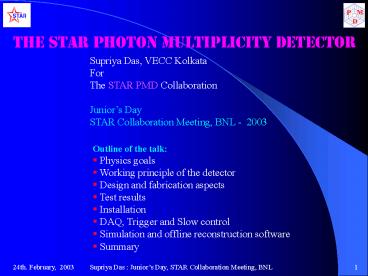The STAR Photon Multiplicity Detector - PowerPoint PPT Presentation
Title:
The STAR Photon Multiplicity Detector
Description:
Supriya Das : Junior's Day, STAR Collaboration Meeting, BNL. 1 ... Junior's Day. STAR Collaboration Meeting, BNL - 2003. Outline of the talk: Physics goals ... – PowerPoint PPT presentation
Number of Views:82
Avg rating:3.0/5.0
Title: The STAR Photon Multiplicity Detector
1
The STAR Photon Multiplicity Detector
Supriya Das, VECC Kolkata For The STAR PMD
Collaboration Juniors Day STAR Collaboration
Meeting, BNL - 2003
- Outline of the talk
- Physics goals
- Working principle of the detector
- Design and fabrication aspects
- Test results
- Installation
- DAQ, Trigger and Slow control
- Simulation and offline reconstruction software
- Summary
2
What does it do?
We measure the multiplicity and spatial
distribution of photons (h,f,dN/dh etc) to study
- The azimuthal anisotropy to determine the
reaction plane and flow as the probes of
thermalization.
- The event by event fluctuations in global
observables like multiplicity and pseudorapidity
distributions following critical phenomena near
phase boundary.
- The distribution of Ng and Ng/Nch with full
azimuthal coverage ( the charged particles info
will be taken from FTPC), looking for signals of
chiral symmetry restoration (e.g. DCC).
3
Recollection from past
Scintillator CCD readout detector sitting 21.5
meters from the vertex covering h 2.9 to 4.2
- Observation of collective flow
- Phys. Lett. B403 (1997) 390.
- Scaling of particle production
- Phys. Lett. B458 (1999) 422.
- DCC Search
- Phys. Lett. B420 (1998) 169
- Phys.Rev.C64011901,2001
- Fluctuations
- Phys. Rev. C, May 2002
4
How does it work?
5
Different features of PMD
- One Unit Module has 576 cells.
- Different Supermodules has different number
- of unit modules (4,6,9 etc.) depending on the
- position on the detector
- Each plain has 12 Supermodules 144
- unit modules
- Supermodules are Gas tight and HV isolated
- Whole detector can be separated in two
- halves
6
Single Cell Design
- Cathode Material 0.2mm thick copper sheet
- Anode wire 20 mm gold plated Tungsten
- Anode wire Tension 25 grams
- End caps standard 1.6 mm thick FR4 PCB
7
Unit Module construction
Unit Module Components
- Each unit module contains
- 24x24 array of cells (576)
- Size of unit module
- Rhombus of side 255 mm
- Weight of unit module 700 gm
Gas - 4 board plugged onto the connector
8
STAR PMD Supermodule assembled in Laboratory
9
Front-end Electronics
The front-end electronics for processing PMD
signals uses 16-channel GASSIPLEX chips.
Gassiplex Chip Testing
10,000 chips have been tested for the full
functionality of each channel.
10
Different Front end boards
11
Supermodule under test in laboratory
- Tests performed on the
- Supermodule
- Gas leak test
- HV test
- Pedestal with FEE boards
- Signal with cosmic muons
12
Test Setup at CERN-PS June 2002
STAR PMD Supermodule
13
Supermodule Test Results I
Pion beam at 5 GeV/c
14
Supermodule Test Results II
Test with electron beams
15
PMD in Wide Angle Hall
16
The suspension mechanism for PMD
17
PMD Installation
18
DAQNumber of Chains and C-RAMS
- One Unit Module (UM) consists of 24x24 576
cells - One UM has 9 Gas - 4 Boards each with 4 chips
- ( 64 Multiplexed channels per board)
- 3 of UM are daisy chained in ONE FEE Chain
- In ONE Chain 27 Nos. Gas-4 boards i.e. 27x64
1728 channels - In total there are 72 UM per plane.
- Two planes 72 x 2 144 Unit Modules.
- Total Number of FEE chains 144/3 48
- One C-RAM has 2 Blocks
- One Block 2K Channels and Total 4K
Channels/C-RAM - 1728 channels/Block i.e. ONE chain/Block will be
used - Total Nos. of C-RAMS required are 24.
19
PMD trigger timing diagram
20
Typical pedestal plot for one FEE chain
21
Slow Control for PMD at STAR
To Main DAQ Network
Fibre Optic
Ethernet Hub for DAQ Network
To Main Slow Control Network
Ethernet Hub for Slow Control Network
Motor Movement Control(PMD)
CAN BUS
MVME 167B
CAN BUS
PL-500 LV unit
PL-500 LV unit
HV Serial
LeCroy 1454 HV Unit
RACK-1
RACK-2
RACK-3
CAN BUS
CAN BUS
CAN BUS
HV Console
PC-Ethernet
Host PC
PC-CAN-USB
22
Journey so far
- Suspension and moving mechanism for PMD has been
installed on - the east wall of the WAH.
- The stainless steel support plate and lead
converter plates have been - installed.
- All LV, HV and signal cables including various
optical cables have - been laid.
- Gas supply and distribution system has been
installed.
- 10 Supermodules have been installed in the last
shut down period.
- 7 FEE chains have been installed and tested.
- Pedestal taken for all seven FEE chains.
- Slow control for Cathode High Voltage, FEE Low
Voltage and VME - crates have been set up and working.
23
Implementation in GSTAR
Front view of PMD in GSTAR
24
Offline reconstruction framework
25
Summary
- Photon Multiplicity Detector is a preshower
detector which measures - the multiplicity and spatial distribution of
photons in the forward region - of STAR.
- In combination with the charged particle data
from the FTPC, it studies - different important physics aspects.
- A major portion of the detector has already been
installed.
- The DAQ, Trigger and Slow control systems has
been set up.
Looking forward for data from dAu and pp runs
for detector Calibration and understanding of
the different aspects of the detector.
Getting ready for real physics data from AuAu
run.































